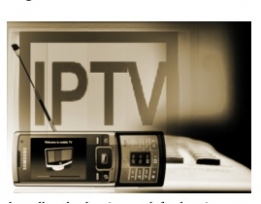New Delivery Channels - Key applications and technologies for mobile TV and IPTV

-
In this scenario, operators need to differentiate their offerings and deliver bundled services to stay competitive. Consequently, a slew of new services is on offer in the market. These include internet protocol TV (IPTV) and high definition TV (HDTV).
IPTV
IPTV is slated to pick up immensely in the Indian market. The platform integrates PCs, video and mobile offerings to ensure that the consumers can do almost anything – from watching TV and movies (via the video and movie-on-demand features) to carrying out interactive gaming to accessing e-applications such as e-learning and tele-voting.
According to Himanshu Sahu, assistant director, business development, UTStarcom, direct to home (DTH) complements IPTV's addressable market.IPTV service offerings target over 80 million homes with cable access, in addition to 40 million homes with fixed line telephones. Research shows that ARPUs are higher for IPTV providers ($170 in 2007) compared to DTH and direct TV providers (about $60 each.)
Meanwhile, the economics of IPTV becomes more favourable by 30 per cent when fibre to the building (FTTB) is combined with passive optical network (PON) technology, as PON allows tiered broadband services of up to 100 Mbps, enabling further options such as video streaming and telepresence.
However, Sahu also points out that there needs to be improved adoption of access technologies, which will drive broadband adoption and further increase the revenue potential of IPTV as well as broadband services.
Mobile TV
Mobile TV and HDTV, according to Arnab Chaudhuri, principal and head of business development, infotainment services, Asia Pacific, Nokia Siemens Networks, enable media services anytime, anywhere and on any device. Mobile TV services allow the consumer to subscribe to internet videos and watch TV over cellular and Wi-Fi networks. Seamless mobile TV is a result of unicast and DVB-H broadcast service convergence.
High definition home TV provides a personal TV experience, offering basic interactive services including voting, betting and advertising. According to Chaudhuri, such forms of convergence entertainment are a win-win proposition.The consumers only have to get one subscription for all TVs on all screens, and can consequently access TV and video services at their convenience.
With the customer and content being the top two priorities, service providers need to ensure that the product is easy to understand and intuitive, affordable and price transparent and of superior quality and relevant content.
For the success of mobile TV, service providers must offer the optimal channel mix. According to Chaudhuri, interoperability and standard alignment of devices also determine mobile TV's market success. While OMA BCAST is the preferred service layer standard, DVB-H is the preferred broadcast standard. 3GPP Rel.6 is the latest streaming standard.
There are many marketing techniques and business models that service providers can use to maximise revenues from mobile TV services. Interactive applications such as online chatting, quizzes, voting, downloads, online purchases and betting generate additional revenue.
For service providers, mobile TV revenues are likely to be substantial as long as they undertake targeted and relevant advertising.
HDTV
Regarding the evolution of IPTV, Kanan Krishnan, country sales manager, connected home solutions, home and networks mobility business, Motorola, feels that HDTV will be the next wave. HDTV and HD-digital video recording (DVR) are becoming more common and more feasible to deploy with improving compression rates. HDTV rates of less than 6 Mbps and standard definition at less than 2 Mbps are now possible and are being deployed by companies like AT&T. MPEG4 increases compression efficiency significantly, and currently delivers 50 per cent bit improvement over MPEG2.
However, there are several challenges for video service providers. Usage and content are growing very rapidly (set-top DVR and real-time service usage is increasing fast). Consequently, the pace of content change is increasing. All this requires greater ingest capacity, higher stream counts and additional storage. Real-time services also necessitate new platforms.
All in all, IPTV, mobile TV and HDTV are definitely the key future growth areas for the Indian telecom sector.
(Based on presentations by Himanshu Sahu, assistant director, business development, UTStarcom; Arnab Chaudhuri, principal and head of business development, infotainment services, Asia Pacific, Nokia Siemens Networks; and Kanan Krishnan, country sales manager, connected home solutions, home and networks mobility business, Motorola)
- Most Viewed
- Most Rated
- Most Shared
- Related Articles
- Manufacturing Hub: India emerges as a ke...
- TRAI performance indicator report for Se...
- Prashant Singhal, partner, telecom indus...
- 2G spectrum scam: continuing controversy
- An Eventful Year: Telecom highlights of ...
- Telecom Round Table: TRAI’s spectrum p...
- Manufacturing Hub: TRAI recommends indig...
- Linking Up: ITIL to merge with Ascend
- High Speed VAS - Killer applications w...
- Bharti Airtel seals deal with Zain - Zai...






